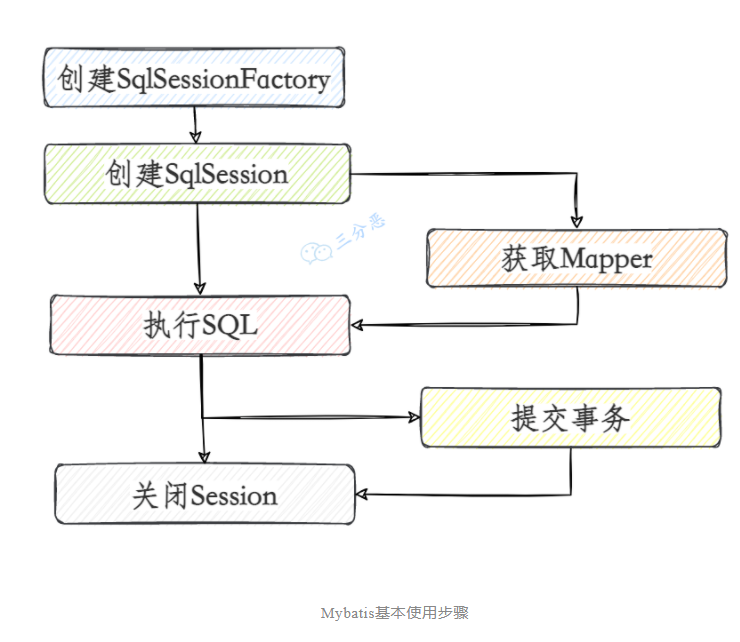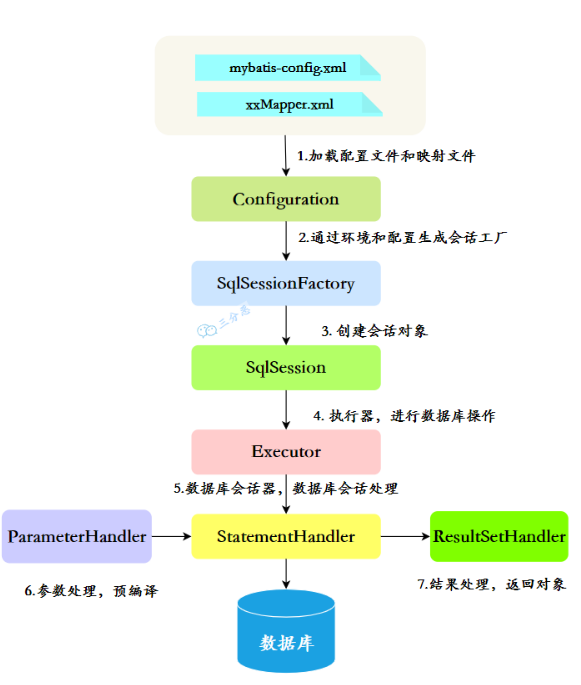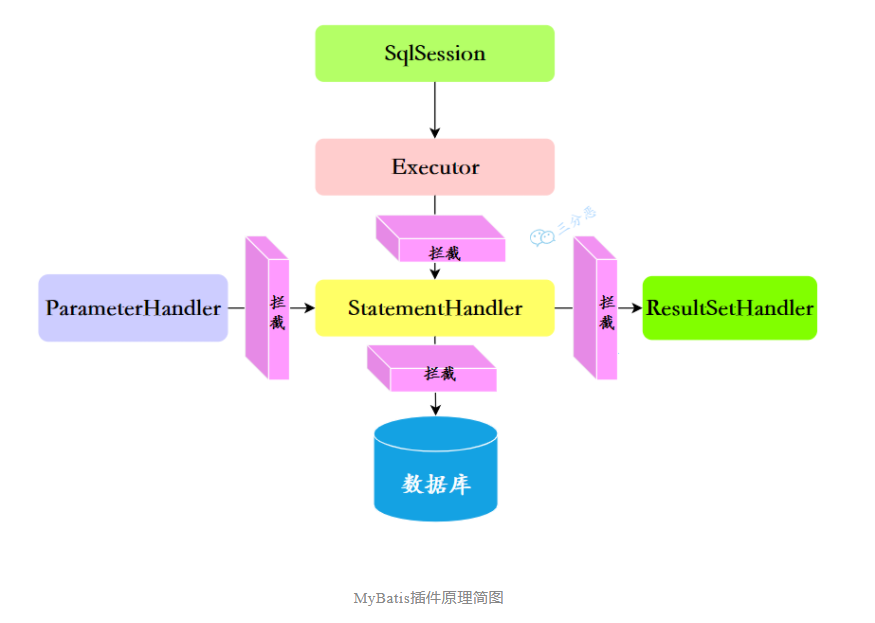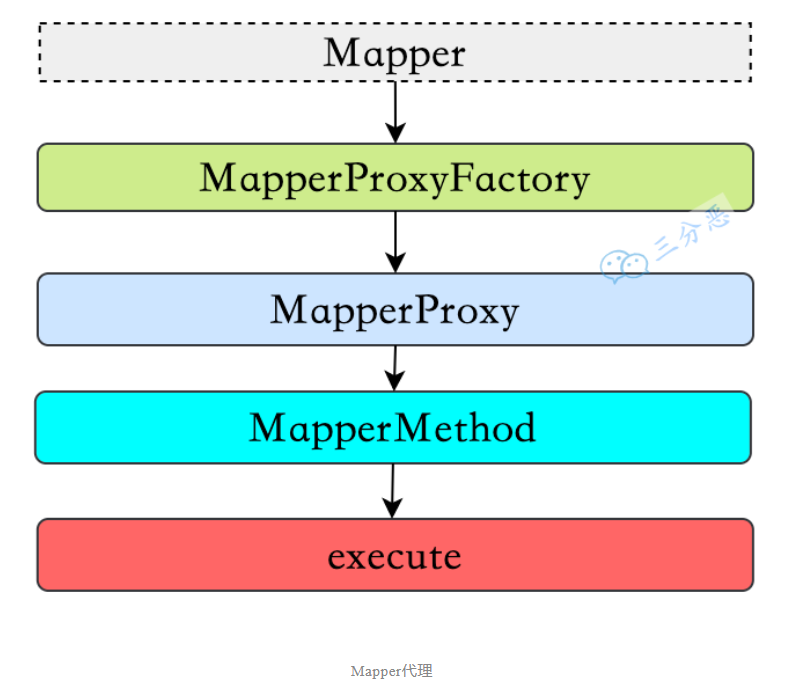Mybatis学习笔记
MyBatis生命周期

创建SqlSessionFactory
javaString resource = "org/mybatis/example/mybatis-config.xml"; InputStream inputStream = Resources.getResourceAsStream(resource); SqlSessionFactory sqlSessionFactory = new SqlSessionFactoryBuilder().build(inputStream);通过SqlSessionFactory创建SqlSession
javaSqlSession session = sqlSessionFactory.openSession();通过sqlsession执行数据库操作
通过 SqlSession 实例来直接执行已映射的 SQL 语句
javaBlog blog = (Blog)session.selectOne("org.mybatis.example.BlogMapper.selectBlog", 101);获取Mapper(映射),然后再执行SQL语句
javaBlogMapper mapper = session.getMapper(BlogMapper.class); Blog blog = mapper.selectBlog(101);
调用session.commit()提交事务
调用session.close()关闭会话
Mybatis工作流程

Mybatis延迟加载
- Mybatis支持association关联对象和collection关联集合对象的延迟加载,association指的就是一对一,collection指的就是一对多查询。在Mybatis配置文件中,可以配置是否启用延迟加载lazyLoadingEnabled=true|false。
- 原理是使用CGLIB创建目标对象的代理对象,当调用目标方法时,进入拦截器方法,比如调用a.getB().getName(),拦截器invoke()方法发现a.getB()是null值,那么就会单独发送事先保存好的查询关联B对象的sql,把B查询上来,然后调用a.setB(b),于是a的对象b属性就有值了,接着完成a.getB().getName()方法的调用。这就是延迟加载的基本原理。
Mybatis缓存
一级缓存
json在同一个SqlSession中发起的多次请求,会将相同的数据缓存起来,后面相同的查询不进行SQL操作数据库 MyBatis默认支持一级缓存,不需要任何配置
一级缓存失效json1.sqlSession不同(每个sqlSession中的缓存相互独立) 2.sqlSession相同,查询条件不同 3.sqlSession相同,两次查询之间执行了增删改操作(增删改操作可能会对当前数据产生影响) 4.sqlSession相同,一级缓存被手动清除[session.clearCache()]
二级缓存
只要是由同一个SqlSessionFactory构造的SqlSession对象,可以缓存数据 MyBatis默认是关闭二级缓存的
操作二级缓存1.主配置文件中设置开启功能
xml<!--Mybatis的配置--> <configuration> <properties resource="jdbc.properties"/> <!--放在该位置--> <settings> <!--开启缓存--> <setting name="cacheEnabled" value="true"/> </settings>2.映射文件中使用缓存
xml<!--使用二级缓存--> <cache/> <cache eviction="FIFO" flushInterval="60000" size="512" readOnly="true"/> <!--这个更高级的配置创建了一个 FIFO 缓存,每隔 60 秒刷新,最多可以存储 结果对象或列表的 512 个引用,而且返回的对象被认为是只读的,因此对它们进 行修改可能会在不同线程中的调用者产生冲突。-->3.将相应的对象数据序列化
javapublic class 类名 implements Serializable {}
Mybatis插件原理
Mybatis会话的运行需要ParameterHandler、ResultSetHandler、StatementHandler、Executor这四大对象的配合,插件的原理就是在这四大对象调度的时候,插入一些我我们自己的代码。

Mybatis使用JDK的动态代理,为目标对象生成代理对象。它提供了一个工具类Plugin,实现了InvocationHandler接口。
public Object invoke(Object proxy, Method method, Object[] args) throws Throwable {
try {
Set<Method> methods = signatureMap.get(method.getDeclaringClass());
if (methods != null && methods.contains(method)) {
return interceptor.intercept(new Invocation(target, method, args));
}
return method.invoke(target, args);
} catch (Exception e) {
throw ExceptionUtil.unwrapThrowable(e);
}
}使用
Plugin生成代理对象,代理对象在调用方法的时候,就会进入invoke方法,在invoke方法中,如果存在签名的拦截方法,插件的intercept方法就会在这里被我们调用,然后就返回结果。如果不存在签名方法,那么将直接反射调用我们要执行的方法
MyBatis分页插件
MyBatis使用
RowBounds对象进行分页,它是针对ResultSet结果集执行的内存分页,而非物理分页。可以在sql内直接书写带有物理分页的参数来完成物理分页功能,也可以使用分页插件来完成物理分页。
分页插件的原理是什么?
- 分页插件的基本原理是使用Mybatis提供的插件接口,实现自定义插件,拦截Executor的query方法
- 在执行查询的时候,拦截待执行的sql,然后重写sql,根据dialect方言,添加对应的物理分页语句和物理分页参数。
- 举例:select * from student,拦截sql后重写为:select t.* from (select * from student) t limit 0, 10
如何编写一个插件?
只需要实现拦截器接口 Interceptor (org.apache.ibatis. plugin Interceptor )在实现类中对拦截对象和方法进行处理。
实现Mybatis的Interceptor接口并重写intercept()方法
java@Intercepts({@Signature( type = Executor.class, //确定要拦截的对象 method = "update", //确定要拦截的方法 args = {MappedStatement.class,Object.class} //拦截方法的参数 )}) public class MyInterceptor implements Interceptor { Properties props=null; @Override public Object intercept(Invocation invocation) throws Throwable { System.out.println("before……"); // 如果当前代理的是一个非代理对象,那么就会调用真实拦截对象的方法 // 如果不是它就会调用下个插件代理对象的invoke方法 Object obj=invocation.proceed(); System.out.println("after……"); return obj; } }MyBatis配置文件里面配置插件
xml<plugins> <plugin interceptor="xxx.MyPlugin"> <property name="dbType",value="mysql"/> </plugin> </plugins>
Mapper动态代理

getMapper(...)
获取Mapper的过程,需要先获取MapperProxyFactory——Mapper代理工厂。
javapublic <T> T getMapper(Class<T> type, SqlSession sqlSession) { MapperProxyFactory<T> mapperProxyFactory = (MapperProxyFactory)this.knownMappers.get(type); if (mapperProxyFactory == null) { throw new BindingException("Type " + type + " is not known to the MapperRegistry."); } else { try { return mapperProxyFactory.newInstance(sqlSession); } catch (Exception var5) { throw new BindingException("Error getting mapper instance. Cause: " + var5, var5); } } }javapublic class MapperProxyFactory<T> { private final Class<T> mapperInterface; …… protected T newInstance(MapperProxy<T> mapperProxy) { return Proxy.newProxyInstance(this.mapperInterface.getClassLoader(), new Class[]{this.mapperInterface}, mapperProxy); } public T newInstance(SqlSession sqlSession) { MapperProxy<T> mapperProxy = new MapperProxy(sqlSession, this.mapperInterface, this.methodCache); return this.newInstance(mapperProxy); } }动态代理对接口的绑定,它的作用就是生成动态代理对象(占位),而代理的方法被放到了MapperProxy中。MapperProxy里,通常会生成一个MapperMethod对象,它是通过cachedMapperMethod方法对其进行初始化的,然后执行excute方法。
javapublic Object invoke(Object proxy, Method method, Object[] args) throws Throwable { try { return Object.class.equals(method.getDeclaringClass()) ? method.invoke(this, args) : this.cachedInvoker(method).invoke(proxy, method, args, this.sqlSession); } catch (Throwable var5) { throw ExceptionUtil.unwrapThrowable(var5); } }
MapperMethod.#execute
java// 这里用到了命令模式,最终还是通过SqlSession的实例去运行对象的sql。 public Object execute(SqlSession sqlSession, Object[] args) { Object result; Object param; …… case SELECT: if (this.method.returnsVoid() && this.method.hasResultHandler()) { this.executeWithResultHandler(sqlSession, args); result = null; } else if (this.method.returnsMany()) { result = this.executeForMany(sqlSession, args); } else if (this.method.returnsMap()) { result = this.executeForMap(sqlSession, args); } else if (this.method.returnsCursor()) { result = this.executeForCursor(sqlSession, args); } else { param = this.method.convertArgsToSqlCommandParam(args); result = sqlSession.selectOne(this.command.getName(), param); if (this.method.returnsOptional() && (result == null || !this.method.getReturnType().equals(result.getClass()))) { result = Optional.ofNullable(result); } } break; …… }
